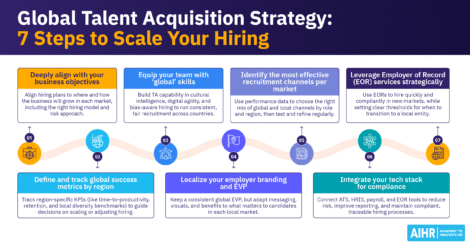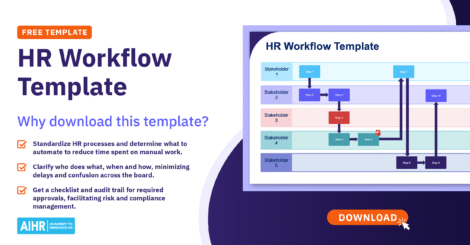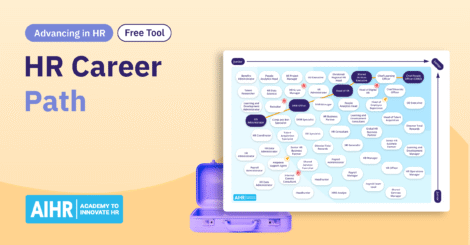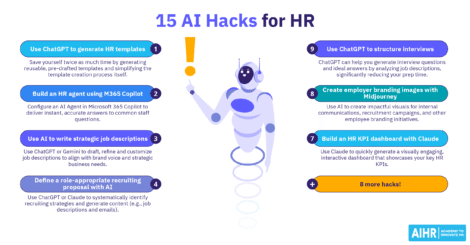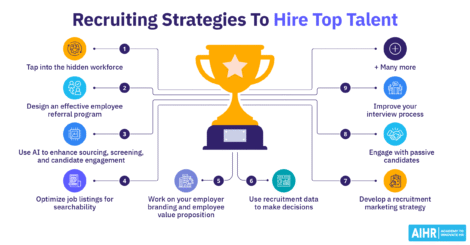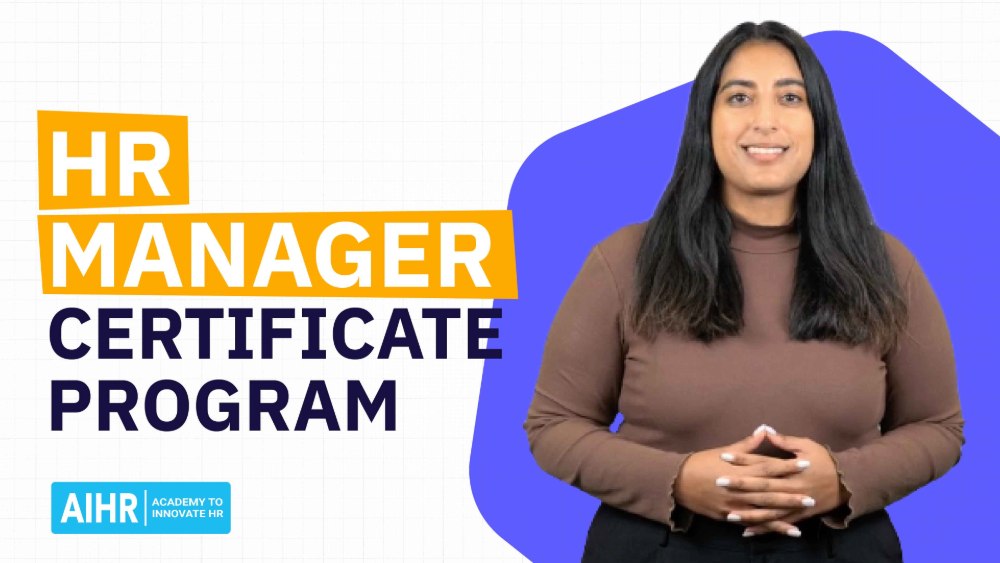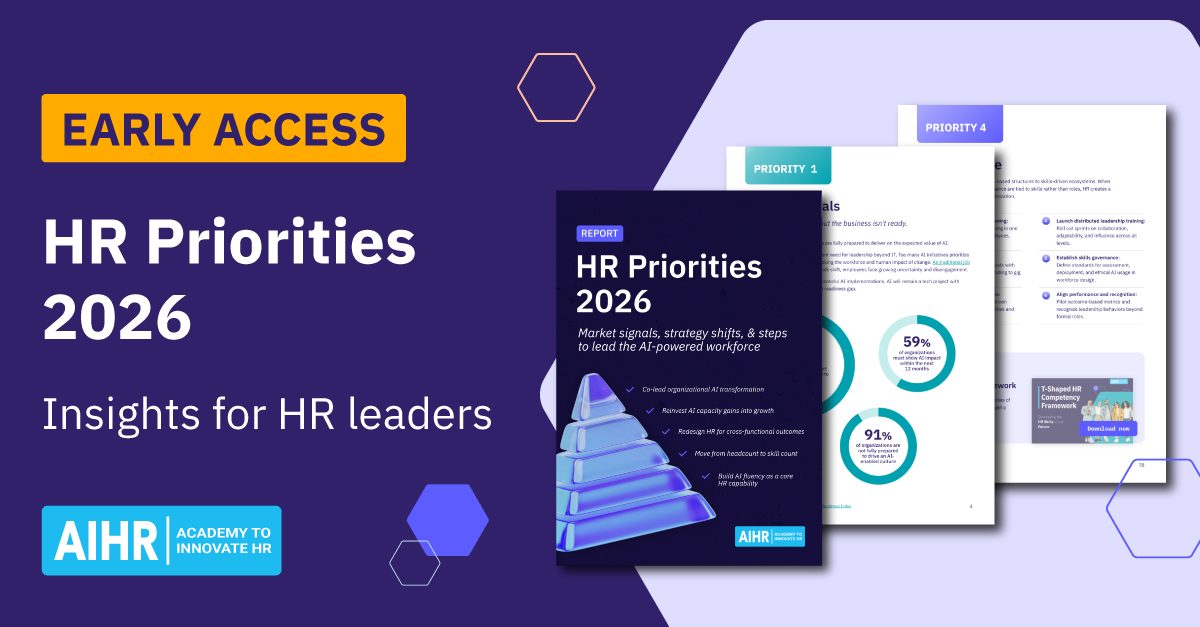HR’s role in business has fundamentally shifted. No longer confined to administrative tasks or policy enforcement, today’s HR function is deeply embedded in how organizations achieve their goals.
Whether it’s hiring talent that aligns with new business growth areas, building leadership capability, or driving initiatives that improve performance and retention, HR now shapes outcomes that matter to the bottom line. Its contribution is measured not only in compliance or engagement scores, but in real business impact — helping companies scale, adapt, and deliver on their strategic objectives.
Let’s take a look at how HR contributes to an organization’s strategy and how you, as an HR leader, can maximize this contribution.
Contents
The growing role of Human Resources in business success
10 ways HR contributes to the organization’s strategy
What can HR do to best support organizational strategy?
FAQ
The growing role of Human Resources in business success
Traditionally, HR was seen largely as an administrative or personnel management function responsible for hiring, payroll, compliance, and maintaining employee records. Its role was often reactive, focused on enforcing rules, managing benefits, and handling employee issues as they came up.
However, as businesses have become more complex and competition for talent has intensified, HR has evolved into a more strategic partner within organizations.
This shift means HR actively shapes company culture, drives employee engagement, develops leadership capability, and aligns talent strategies with broader business goals. Rather than just supporting the business, HR is now helping to drive it by taking on a critical role in areas like workforce planning, organizational design, and change management to make sure that the right people, skills, and structures are in place for sustainable growth.
To understand the cause-and-effect relationship between HR initiatives and business performance, let’s take a look at the HR Value Chain model, which illustrates how HR’s impact goes beyond “soft” people practices to delivering measurable value instead.

- HR activities and processes include core functions like recruitment, training, performance management, and employee engagement. They lead to efficiency.
- These activities feed into HR outcomes, such as higher employee engagement, reduced turnover, and increased skill levels. This is the HR effectiveness.
- The HR outcomes then translate into impact on organizational objectives like profit, market value, and improved customer satisfaction.
By aligning HR strategy with business strategy and then tracking how people initiatives influence performance metrics, HR can prove its role as a driver of organizational success.
With this in mind, let’s unpack how HR professionals add significant value to companies worldwide.
When HR operates strategically, it can transform an organization’s future. But building a truly strategic HR function doesn’t happen overnight—it takes the right skills, mindset, and tools.
AIHR for Teams helps you empower your entire HR department to contribute at the highest level. Our online, self-paced programs equip teams with future-proof skills in areas like talent management, people analytics, AI for HR, organizational development, and digital HR to drive business impact and strategic growth.
10 ways HR contributes to the organization’s strategy
Strategic HR moves past routine policies and procedures to focus on aligning people practices with business goals, making sure the organization has the skills, mindsets, and leadership it needs for long-term success.
The following examples highlight ten powerful ways HR contributes directly to the organization’s strategic agenda.
1. Talent acquisition
Hiring the right people for the right roles is fundamental to achieving an organization’s goals. Rather than merely filling vacancies, strategic recruitment builds a workforce aligned with the company’s goals, whether entering a new market, launching a new product, or delivering better service.
In action
Atlassian exemplifies strategic recruitment that goes beyond filling roles, focusing on curating a workforce that shapes the company’s trajectory. Whether entering a new market or scaling globally in a remote-first environment, hiring the right people is fundamental.
Atlassian’s approach starts with a holistic hiring process that evaluates technical skill, cultural fit, leadership acumen, and strategic problem-solving. Candidates aren’t just assessed on their capabilities — they must demonstrate their thinking, collaboration, and alignment with long-term goals.
Hiring is a strategic pillar at Atlassian to maintain their edge, scale globally, and deliver on their mission in a culturally and operationally resilient way. Atlassian’s remote-first success relies on hiring people who thrive in a distributed setting and embody the company’s values of trust, transparency, and innovation.
Its interview process emphasizes real-world problem-solving, architectural thinking, and decision-making for sustainable, scalable systems. The company looks for individuals who can anticipate future needs, ensuring alignment with Atlassian’s future-forward culture.
2. Employee training and development
Upskilling and reskilling help employees stay adaptable, ready to work with new technologies, respond to shifting market demands, and take on more strategic responsibilities. For the business, this means greater agility, stronger talent pipelines, and better execution of long-term goals. These processes also prepare future leaders and support succession planning, ensuring long-term continuity.
In action
Capgemini’s strong commitment to employee training and development is showcased through its Accelerate Programme designed for graduates. For example, its Analytics & AI track helps early-career professionals build strong foundations in data, analytics, and AI through a combination of structured learning, mentoring, and real-world project work.
The program blends theoretical knowledge with practical application, preparing participants for roles like data analysts and AI specialists. This helps support both individual career growth and Capgemini’s broader goals around digital transformation and innovation.

3. Performance management
Modern performance management focuses on creating a continuous feedback loop that connects individual contributions to business objectives, not limiting the process to annual reviews. Done well, it boosts motivation, productivity, and focus on what really matters.
In action
Microsoft’s evolution of its performance management system showcases how large enterprises are rethinking traditional models in favour of agility, clarity, and employee empowerment. Moving away from rigid annual reviews, Microsoft has adopted a system rooted in continuous feedback and growth mindset principles.
Central to this shift is the introduction of tools like the “ManageRewards slider,” which lets managers assess and reward performance with more nuance. Rather than relying on numeric ratings or stack rankings, this tool helps evaluate an employee’s impact based on contribution, collaboration, and alignment with business outcomes, supporting tailored performance conversations.
This approach is in line with Microsoft’s leadership philosophy that performance is about outcomes and how they’re achieved. Employees are encouraged to embrace a growth mindset, learning from feedback, taking risks, and improving, which is further reinforced in the performance management process.
Microsoft is building an environment where employees feel supported in their development instead of judged by static metrics. The system also offers greater flexibility to managers, letting them provide meaningful recognition and development opportunities in real time without waiting for the annual review cycle.
4. Organizational culture
Culture acts as an organization’s operating system. A strong, aligned culture promotes behaviors that drive strategic objectives, including innovation, collaboration, or customer focus. It’s a critical lever for engagement, productivity, and adaptability.
In action
Zappos is well-known for its customer-centric culture. At the heart of Zappos’ success is its commitment to core values that permeate every aspect of the company. These values, including “Deliver WOW Through Service” and “Create Fun and A Little Weirdness,” are integrated into hiring, training, and daily operations, creating a vibrant culture that promotes behaviors aligned with the company’s goals.
This cultural foundation empowers employees to make decisions that best serve customers and supports ownership and accountability. Zappos’s flat, team-based structure, known as holacracy, enables flexibility and autonomy, letting employees innovate and drive change without traditional hierarchies.
5. Compliance and risk management
By ensuring adherence to laws, regulations, and internal policies, HR reduces the risk of legal issues, financial penalties, and reputational damage. Internally, this also builds a trustworthy, transparent environment, which supports employee morale and brand credibility.
In action
Woolworths Group in Australia is a great example of how HR-led compliance efforts mitigate legal and financial risks while restoring trust and protecting brand reputation.
Following the discovery of widespread underpayment issues, particularly concerning long service leave entitlements, Woolworths took a proactive and transparent approach. Rather than downplaying the issue, the company launched a comprehensive wage compliance review, engaged with regulators, and acknowledged shortcomings in its payroll practices. The Victorian Wage Inspectorate fined Woolworths over AU$1.1 million for breaches affecting thousands of employees, but the company’s swift and cooperative response softened any further reputational damage.
Woolworths invested in overhauling its payroll systems and strengthening internal processes through better training and governance. These reforms reflect a longer-term HR strategy prioritizing legal compliance, operational transparency, and ethical leadership.
6. Data-driven decision-making
HR analytics helps leaders make evidence-based decisions around workforce planning, engagement, performance, and retention. This leads to more effective strategies that are responsive to real trends and risks.
In action
eBay’s use of HR analytics shows how data-driven insights can enhance workforce planning, engagement, performance, and retention.
Through advanced analytics tools, eBay’s HR team can identify workforce patterns and trends, helping leaders make informed decisions that align with organizational goals. For instance, by analyzing employee data, eBay can pinpoint factors contributing to turnover and proactively address them through targeted interventions like tailored career development programs and personalized engagement strategies.
Thanks to this evidence-based approach, eBay has reduced attrition rates and created a more engaged and productive workforce. Continuously monitoring and analyzing HR metrics also allows the company to proactively adapt its strategies to meet evolving employee needs and market dynamics.
7. Change management
Strategic growth often involves change, whether digital transformation, a merger, or organizational restructuring. HR is central to guiding people through these transitions, minimizing disruption, and ensuring change sticks.
In action
Microsoft’s transformation under CEO Satya Nadella is a case study in strategic growth and change management. When Nadella took over in 2014, he shifted from a ‘know-it-all’ culture to a ‘learn-it-all’ mindset, emphasizing continuous learning and collaboration.
This cultural change supported Microsoft’s transition to a cloud-first model, which required adaptation to the new technology reality. The company actively created an environment of experimentation and learning from failure to innovate effectively and align its workforce with new objectives.
HR played a key role in guiding employees through the transition by implementing leadership development programs and employee engagement initiatives that reinforced the new cultural values. These efforts ensured that employees were informed about the changes and equipped with the skills and mindset to thrive in the new environment. The emphasis on empathy and open communication minimized disruption and drove trust and transparency throughout the organization.
8. Diversity, equity, and inclusion (DEI)
Implementing DEI initiatives ensures a diverse workforce where all employees feel valued and included. This enhances innovation and decision-making, aligns with broader societal expectations, and can improve market reach.
In action
Despite a trend of scaling back DEI initiatives, Cisco has maintained and strengthened its commitment, earning the top spot on the Financial Times-Statista list of European Diversity Leaders. One standout program is the ‘proximity initiative,’ which encourages leaders to engage in one-on-one conversations with colleagues from different backgrounds to build empathy, promote allyship, and drive behavioral change.
Cisco prioritizes pay equity by conducting annual reviews of salaries, promotions, and bonuses to ensure fairness across gender, race, and ethnicity. This approach has led to adjustments for 1% to 2% of employees each year, reinforcing the company’s commitment to equitable compensation. Cisco’s flexible work policies and diverse talent accelerators have also contributed to low attrition rates and a more inclusive culture.
9. Employee wellbeing
Comprehensive wellbeing programs address employees’ physical, mental, and emotional health, leading to increased engagement, reduced absenteeism, and higher productivity — all of which contribute to organizational success.
In action
After the COVID-19 pandemic and George Floyd’s murder in 2020, Entrust saw a significant rise in mental health claims and performance-related complaints. Recognizing the need for better support, Chief Human Resources Officer Beth Klehr led a restructuring of the company’s wellness initiatives.
This introduced one-on-one mental health coaching, meditation seminars, and social gatherings to build community and well-being among staff. The shift marked a departure from previous HR guidance that discouraged open discussions about mental health, moving into a new era of transparency and support.
Entrust’s revamped wellness programs have yielded noteworthy results. Participation in the fitness program averages 139 employees monthly, and membership in employee resource groups has doubled from 10% in 2022 to over 20% in 2024. Employee feedback has been overwhelmingly positive, with staff stating these initiatives have profoundly impacted their personal and professional lives.
10. Integration of Artificial Intelligence (AI)
HR plays a crucial role in facilitating the adoption of AI by providing training and development programs that equip employees with the necessary skills, ensuring the organization remains competitive in the technology-driven market.
In action
Recognizing the transformative impact of AI on various industries, Intel’s strategic approach has been to proactively launch initiatives aimed at equipping both current and future employees with essential AI competencies.
A cornerstone of this effort is the ‘AI for Workforce’ program, which offers over 500 hours of free AI content to U.S. community colleges. This program provides technical training and emphasizes responsible AI usage, ensuring that participants are prepared to navigate the ethical considerations associated with AI technologies.
Beyond educational institutions, Intel’s HR leadership, spearheaded by Chief People Officer Christy Pambianchi, has been instrumental in promoting a culture of transparency and ethical AI implementation within the organization. The company advocates for human-centered AI principles and encourages open dialogues about AI’s role in the workplace, keeping employees both informed and engaged in the company’s digital transformation journey.
What can HR do to best support organizational strategy?
For HR to influence strategy, it must operate with intention, insight, and credibility. That means moving beyond traditional administrative functions to become an architect of business capability. Supporting strategy involves understanding it deeply, anticipating workforce needs, and helping shape organizational readiness for change.
HR professionals must think like business leaders—aligning initiatives with strategic goals, using data to guide decisions, and building a workforce prepared for the future.
Here are specific actions that HR professionals can take to amplify HR’s strategic value across the organization.
Build business acumen across the HR team
HR can’t contribute to strategy without understanding it. Encourage your team to learn how the organization generates revenue, what matters most to customers and competitors, and what the executive team aims to achieve. This business knowledge lets HR design relevant and timely initiatives. For example, if the business is aiming to enter new markets, HR can anticipate the talent profiles, training needs, and cultural considerations that will be required.
Develop influence within the organization
To truly support strategy, HR must be seen as more than a policy enforcer or a support function. HR leaders must build credibility with senior leaders and functional heads by consistently bringing valuable insights to the table, including workforce risks, engagement data, or succession gaps. Influence is earned when HR helps solve organization-wide problems, not just HR problems.
Align HR initiatives with business goals
Every HR initiative, from employee onboarding to leadership development, should be clearly connected to the organization’s strategic priorities to ensure that HR is not operating in a silo. For instance, if innovation is a strategic goal, HR can focus on building cross-functional teams, incentivizing experimentation, and recruiting from diverse talent pools.
The HR Value Chain is a helpful tool here, showing how HR activities translate into outcomes that matter to the business.
Use data to guide decisions and measure impact
Gut feeling is no longer enough. Today’s HR leaders must use workforce analytics to identify issues, make informed decisions, and track results. For example, predictive analytics can flag potential turnover issues, while performance data can help refine incentive structures.
When HR can present numbers showing how a change in process led to improved productivity or reduced attrition, its role as a strategic driver becomes undeniable.
Get involved early in strategic planning
HR should be in the room when strategic decisions are made, not just after the fact to implement them. Being involved early lets HR identify workforce implications, surface potential talent constraints, and ensure that strategies are built on a realistic understanding of people and capabilities.
Early involvement also gives HR time to prepare the organization for change through conducting a change impact assessment, drafting communication and training plans, or suggesting structural adjustments.

Stay current on external trends
Labor market dynamics, emerging technologies, regulation updates, and evolving employee expectations can all affect how a business executes its strategy. HR leaders should monitor these external trends and use that insight to guide workforce planning and organizational readiness.
For example, understanding the growing demand for remote work or AI literacy can shape recruitment, retention, and development strategies to keep the business competitive.
Design for agility and adaptability
The pace of change in today’s business environment demands that organizations be flexible and responsive. HR can lead by designing structures, roles, and processes that support agility, like flatter hierarchies, cross-functional teams, and more fluid talent deployment. Building a bench of generalist leaders who can shift roles as needed helps the business respond faster to new opportunities or threats.
Champion a future-ready workforce
HR should scan the horizon to understand what skills the organization will need in the future and start building them now. Depending on the business context, this could mean investing in digital skills, leadership resilience, or sustainability know-how. A future-ready workforce is a competitive advantage, and HR is key in shaping it through talent planning, upskilling, and career pathing.
Embed purpose and values in the employee experience
Organizations with a strong sense of purpose and clear organizational values tend to outperform their peers, especially in terms of engagement and retention. HR can reinforce strategy by ensuring those values are present in recruitment, onboarding, performance management, and recognition. Employees who see a direct link between their work and the company’s mission are likely to go above and beyond.
Strengthen leadership at all levels
Strategy is executed through people, and people look to their leaders. HR should invest in building leadership capability across all levels beyond just the executive team. Strong leaders help teams navigate change, make good decisions, and stay aligned with business goals. This includes providing leadership development plans, coaching, and feedback mechanisms that cultivate accountability and effectiveness.
Support strategic change with communication and engagement
Even the best strategies can fail without buy-in from the workforce. HR is vital in crafting clear, consistent communication that helps employees understand the “why” behind strategic changes. Creating feedback loops, listening to concerns, and helping managers cascade key messages are essential here. Engaged employees are far more likely to support and contribute to the success of strategic initiatives.
To sum up
HR has firmly established itself as a strategic partner in business, going far beyond traditional administrative roles. By aligning people practices with business objectives, HR helps build the capabilities, culture, and resilience that organisations need to thrive. From attracting and developing talent to embedding values, managing change, and leveraging data, HR plays a direct and measurable role in driving performance, innovation, and long-term success.
Strategic HR isn’t a ‘nice to have’ — it’s a critical enabler of competitive advantage. When HR is involved early, armed with insight, and empowered to act, it ensures that strategy is not only formulated but fully delivered through the people who make it happen.
FAQ
HR impacts company strategy by ensuring the organization has the right people, capabilities, and culture to execute its goals. From workforce planning to talent development, HR aligns its initiatives, like recruitment, training, performance management, and employee engagement, with the company’s strategic priorities. By shaping a skilled, motivated, and adaptable workforce, HR plays a critical role in enabling long-term business success.
In strategic planning, Human Resources Management helps identify the workforce implications of business goals and ensures the organization is ready to deliver on them. HR provides input on talent availability, skills gaps, leadership capacity, and change readiness, which are factors that can make or break a strategy. HR should be involved early in the planning process to influence decisions, align people initiatives with priorities, and help design realistic and executable strategies.
HR contributes to business effectiveness by optimizing hiring, developing, managing, and retaining people. Effective HR practices improve productivity, reduce turnover, boost engagement, and ensure compliance, all of which support better performance. Through initiatives like leadership development, employee wellness, and data-driven decision-making, HR enhances the organization’s ability to compete, adapt, and grow in a fast-changing environment.










